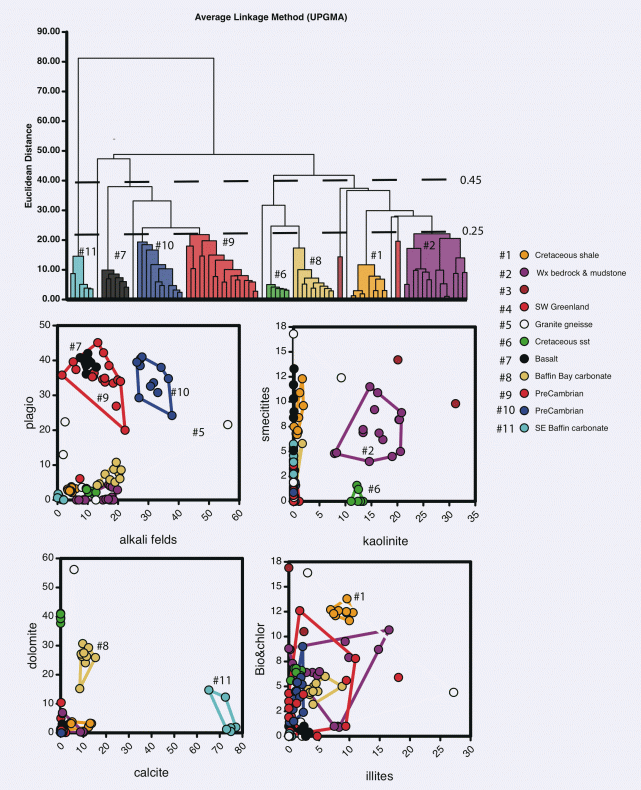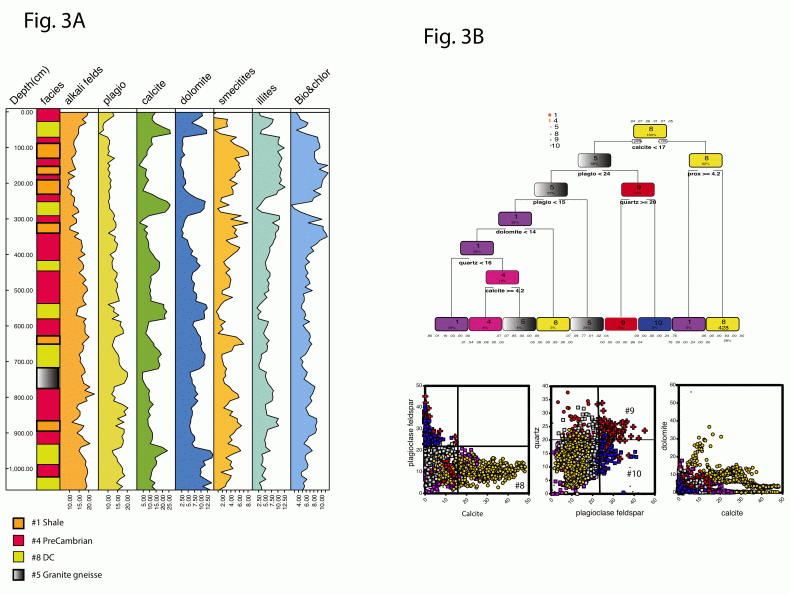The author(s) will give a talk
Changes in sediment sources in the Labrador Sea during the Late Quaternary
1 University of Colorado
2 Geological Survey of Canada--Atlantic
Studies of the sediment history in the Labrador Sea have frequently focused on the detrital carbonate facies associated with Heinrich events sourced from the collapse of the Hudson Strait Ice Stream and linked to long-distance iceberg transport (Andrews and Tedesco 1992; Bond et al. 1992; Rashid et al. 2003) as well as the generation of turbidites that flowed toward and down the North Atlantic Mid-Ocean Channel (Chough et al. 1987; Hesse 2016; Hesse and Khodabakhsh 2016). In this presentation we use a data base of 1445 sediment samples from cores and surface samples (Fig. 1) to evaluate whether we can detect spatial and temporal changes in mineral compositions during the late Quaternary and Holocene, remembering that in this glacial marine environment we must expect mixing of provenance indicators. We use a suite of 90 bedrock and IRD-clasts to understand the range of non-clay and clay mineral compositions that could be transported to the Labrador Sea by glacial erosion and transport, and then use this supervised data set to predict the origins of the 1445 samples. The supervised analysis resulted in 10 distinct compositional entities (Fig. 2) and we illustrate the application by showing the downcore variations in mineral wt% and predicted mineral facies for HU2011031-059 on northern Flemish Cap (Mao et al. 2014) (Fig. 3A). We test the robustness of the predictions by using the non-parametric Classification Decision Tree program “rpart” (Fig. 3B). This indicated that only 18% of the samples were misclassified. One of the important issues that we are currently examining is whether the four granitoid-rich facies have specific provenance value.
Acknowledgements: This project was started by Jeremy Hoffman as part of a PhD project at Oregon State University supported by NSF. We thank Kate Jarrett and other staff at GSC-Atlantic for their assistance in sampling the many cores used in this study.
Andrews, J.T., and Tedesco, K. 1992. Detrital carbonate-rich sediments, northwestern Labrador Sea: Implications for ice-sheet dynamics and iceberg rafting (Heinrich) events in the North Atlantic. Geology, 20: 1087-1090.
Bond, G., Heinrich, H., Broecker, W.S., Labeyrie, L., McManus, J., Andrews, J.T., Huon, S., Jantschik, R., Clasen, S., Simet, C., Tedesco, K., KLas, M., Bonani, G., and Ivy, S. 1992. Evidence for massive discharges of icebergs into the glacial Northern Atlantic. Nature, 360: 245-249.
Chough, S.K., Hesse, R., and Muller, J. 1987. The Northwest Atlantic Mid-Ocean Channel of the Labrador Sea. IV. Petrography and provenance of the sediments. Canadian Journal Earth Sciences, 24: 731-740.
Hesse, R. 2016. Ice-proximal Labrador Sea Heinrich layers: a sedimentological approach. Canadian Journal of Earth Sciences, 53: 71-100. doi:10.1139/cjes-2015-0033.
Hesse, R., and Khodabakhsh, S. 2016. Anatomy of Labrador Sea Heinrich layers. Marine Geology, 380: 44-66.
Mao, L., Piper, D.J.W., Saint-Ange, F., Andrews, J.T., and Kienast, M. 2014. Provenance of sediment in the Labrador Current: a record of hinterland glaciation over the past 125 ka. Journal of Quaternary Science, 29: 650-660. doi:10.1002/jqs.2736.
Rashid, H., Hesse, R., and Piper, D.J.W. 2003. Distribution, thickness and origin of Heinrich layer 3 in the Labrador Sea. Earth and Planetary Science Letters, 205: 281-293.

Fig 1.
Map of the core and sample sites.

Fig 2.
Hierarchical dendrogram based on 90 bedrock or IRD-clast samples.

Fig 3.
A: Downcore plot of data from HU2011-059 (Mao et al., 2014) showing the predicted mineral facies. B) Classification Decision Tree of the predicted unsupervised core data based on Fig. 2